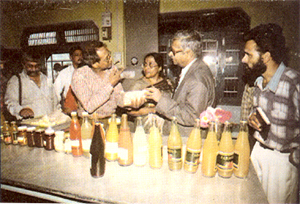|
Problem/Need Indian
ranks first in the world, in terms of horticultural
produce, with an annual production of over 102 million
tones of fruits and vegetables. However, an estimated
30% of this goes waste since in the absence of facilities
for preservation, the perishable fruits/vegetables
are unable to reach the consumers in time. This
is compounded by meagre utilization (less than 5%)
by the fruit/vegetable processing industry. This
may be compared to 30-70% utilization by processing
industries in South-East Asian countries. Other
factors for destruction of the produce are lack
of efficient transportation and low prices to middlemen
and contractors. These distress sales are all the
more debilitating for small and marginal farmers
who produce a larger proportion of fruits and vegetables.
Thus, not only is a valuable source of nutrition
wasted, but its producers face impoverishment and
misery. On the other hand consumers are left at
the mercy of avaricious wholesale dealers and the
organized sector producing high–cost branded
products. Though in recent years India has witnessed
a shift towards the use of processed fruits and
vegetables, there exists a vast and growing demand
for such products, both at the rural and urban levels.
Approach/Strategy A
technology package evolved by CTD to tackle this
problem aims at setting up and operating economically
viable and self-sustaining rural industries for
processing of horticultural produce, as close to
the source of raw materials as possible. Suitably
descaled and adapted equipment and some innovative
technologies are utilized for this purpose. A network
of small producers is established from whom the
raw produce is bought at remunerative prices. Processing
is undertaken at different levels – home,
satellite unit, nodal unit – mainly by women.
Strict quality control is built into the system,
with suitable legal standards being adopted. Packaging
and marketing is undertaken centrally. Local markets
are tapped for the sale of products to the maximum
extent possible, thus obviating the need for transportation.
The VO manages and coordinates all the activities
from networking of growers to marketing the products,
and also provides technical backup and support.

Range of Innovative Products
like Apricot Juice
Technology Package
To process and preserve the huge range of horticultural
products available in the country, there exist diverse
technologies, which have been standardized under
field conditions. The exact choice will depend on
the nature of raw produce available and its quantum.
An illustrative list is being given below to indicate
the various types.
Pulping/Juicing:
This involves extraction of edible pulp and/or juice
from the fruit, which can be used as such, or further
processed, if required. For example, various products
obtainable by pulping/juicing of some fruits are:
|
| Product
Profile (illustrative) |
|
| Pulp/Juice/Jams
and Jellies |
|
| Produce |
Product |
| Tomato |
Pulp,
Puree, Sauce/Ketchup |
| Apple |
Juice/Concentrate
|
| Citrus
fruits |
Squash/cordial |
| Fleshy
fruits |
Pulp,
Juice, Nectar |
| Guava |
Jelly |
| Dries/Osmo-dehydrated
|
|
| Produce |
Product
|
| Onion |
Powder/Paste |
| Potato |
Chips |
| Garlic |
Powder/Paste |
|
Ginger/Turmeric |
Powder |
| Mango |
Powder
(amchur) |
| Mango/Jackfruit |
Leather |
| Apple |
Chips |
| Papaya/Pumpkin |
Candy |
Fermentation
|
|
| Produce |
Product |
| Mango,
citrus fruits, vegetables like carrots,
Jackfruit, Cauliflower, Bamboo shoot, etc.
|
Pickles
|
| Cabbage
|
Sauerkraut
(by lactic acid fermentation) |
|